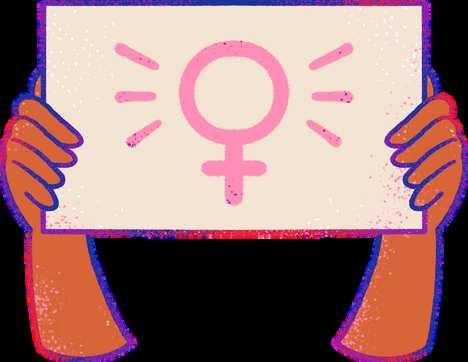
4 minute read
THE GENDER GAP IN HEALTH: UNDERSTANDING ACCESS TO HEALTHCARE FOR WOMEN
Women's health is a nation's health. That's why there is a responsible task before medical establishments and the society to insure the safety and hygiene of women. They should decrease number of diseases appearing in women and prevent their appearing. This task is rather complicated, because of contemporary conditions and new risk factors of disease development in women which arise in connection with population migration, urbanization, change of young people's sexual mentality : early beginning of sexual life, irresponsible of society in context of marriage and conjugal infidelity. All these factors put under treat the future health of these women. These all factors reflects demographic indexes and is extraordinarily important for the state as a whole.
Few of the main issues regarding women's health are:
Advertisement
Cancer: Two of the most common cancers affecting women are breast and cervical cancers. Detecting both these cancers early is key to keeping women alive and healthy. The latest global figures show that around half a million women die from cervical cancer and half a million from breast cancer each year. The vast majority of these deaths occur in low and middle income countries where screening, prevention and treatment are almost non-existent, and where vaccination against human papilloma virus needs to take hold. Reproductive health: Sexual and reproductive health problems are responsible for one third of health issues for women between the ages of 15 and 44 years. Unsafe sex is a major risk factor-particularly among women and girls in developing countries. This is why it is so important to get services to the 222 million women who aren't getting the contraception services they need.
Maternal health: Many women are now benefitting from massive improvements in care during pregnancy and childbirth introduced in the last century. But those benefits do not extend everywhere and in 2013, almost 300,000 women died from complications in pregnancy and childbirth. Most of these deaths could have been prevented,had access to family planning and to some quite basic services been in place.
HIV: Three decades into the AIDS epidemic, it is young women who bear the brunt of new HIV infections. Too many young women still struggle to protect themselves against sexual transmission of HIV and to get the treatment they require. This also leaves them particularly vulnerable to tuberculosis-one of the leading causes of death in low-income countries of women 20-59 years.
Sexually transmitted infections: I've already mentioned the importance of protecting against HIV and human papillomavirus (HPV) infection (the world's most common STI). But it is also vital to do a better job of preventing and treating diseases like gonorrhoea, chlamydia and syphilis. Untreated syphilis is responsible for more than 200,000 stillbirths and early foetal deaths every year, and for the deaths of over 90,000 newborns.
Violence against women: Women can be subject to a range of different forms of violence, but physical and sexual violence-either by a partner or someone else-is particularly invidious.Today, one in three women under 50 has experienced physical and/or sexual violence by a partner, or non-partner sexual violenceviolence which affects their physical and mental health in the short and long-term. It's important for health workers to be alert to violence so they can help prevent it, as well as provide support to people who experience it.
Mental health: Evidence suggests that women are more prone than men to experience anxiety,depression, and somatic complaints-physical symptoms that cannot be explained medically. Depression is the most common mental health problem for women and suicide a leading cause of death for women under 60. Helping sensitise women to mental health issues, and giving them the confidence to seek assistance is of importance.
Being young: Adolescent girls face a number of sexual and reproductive health challenges: STIs, HIV, and pregnancy. About 13 million adolescent girls (under 20) give birth every year.Complications from those pregnancies and childbirth are a leading cause of death for those young mothers.Many suffer the consequences of unsafe abortion.
Women menstrual hygiene: Poor menstrual hygiene, however, can pose serious health risks, like reproductive and urinary tract infections which can result in future infertility and birth complications.

Few hygienic practices which can improve menstrual health of women are:
Wash your hands before and after using the restroom and before using a menstrual product.
Discard used disposable menstrual products properly.
Sanitary pads:Change sanitary pads every few hours,no matter how light the flow. Change them more frequently if your period is heavy.

Tampons: Change tampons every 4 to 8 hours. Do not wear a single tampon for more than 8 hours at a time.
Use the lowest-absorbency tampon needed.If you can wear one tampon for up to 8 hours without changing, the absorbency may be too high.
Menstrual cups: Clean cups every day after use. Sanitize menstrual cups after your period is over by rinsing them thoroughly and then placing them in boiling water for one to two minutes.
Premenstrual Dysphoric Disorder: PMDD is a much more severe form of premenstrual syndrome (PMS). It may affect women of childbearing age. It's a severe and chronic medical condition that needs attention and treatment. Lifestyle changes and sometimes medicines can help manage symptoms. The exact cause of PMDD is not known. It may be an abnormal reaction to normal hormone changes that happen with each menstrual cycle. The hormone changes can cause a serotonin deficiency. Serotonin is a substance found naturally in the brain and intestines that narrows blood vessels and can affect mood and cause physical symptoms. While any woman can develop PMDD, the following may be some risk factor:Women with a family history of PMS or PMDD. Women with a personal or family history of depression, postpartum depression, or other mood disorders. Symptoms of PMDD appear during the week before menstruation and end within a few days after menstruation starts.
The following are the most common symptoms of PMDD
Depressed mood
Anger or irritability
Trouble concentrating
Lack of interest in activities once enjoyed
Moodiness.
Increased appetite.
Insomnia or the need for more sleep.
Feeling overwhelmed or out of control.

